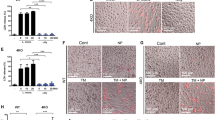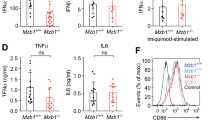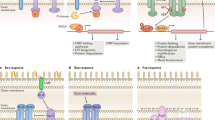Abstract
Chaperone proteins are thought to promote the correct folding and assembly of newly synthesized proteins and to facilitate restoration of the folded state under environmental conditions that favour protein denaturation. They are among the most ubiquitous and highly conserved of all proteins. The eukaryotic endoplasmic reticulum (ER) chaperone gp96 in particular has long been thought to be indispensable for cell survival. Here we report that a screen for genes required for the immune response to bacterial endotoxins has identified a B-cell line deficient in gp96. Absence of gp96 is compatible with cellular survival even under stress conditions and causes a defect in the formation of only a small subset of cell surface receptors. Toll-like receptors are retained intracellularly in the absence of gp96, explaining the unresponsiveness of the mutant to microbial stimuli.
This is a preview of subscription content, access via your institution
Access options
Subscribe to this journal
Receive 12 print issues and online access
$209.00 per year
only $17.42 per issue
Buy this article
- Purchase on Springer Link
- Instant access to full article PDF
Prices may be subject to local taxes which are calculated during checkout






Similar content being viewed by others
References
Aderem, A. A. & Ulevitch, R. J. Toll-like receptors in the induction of the innate immune response. Nature 406, 782–787 (2000).
Wright, S. D., Ramos, R. A., Tobias, P. S., Ulevitch, R. J. & Mathison, J. C. CD14, a receptor for complexes of lipopolysaccharide (LPS) and LPS binding protein. Science 249, 1431–1433 (1990).
Poltorak, A. et al. Defective LPS signaling in C3H/HeJ and C57BL/10ScCr mice: mutations in Tlr4 gene. Science 282, 2085–2088 (1998).
Hoshino, K. et al. Cutting edge: Toll-like receptor 4 (TLR4)-deficient mice are hyporesponsive to lipopolysaccharide: evidence for TLR4 as the Lps gene product. J. Immunol. 162, 3749–3752 (1999).
Qureshi, S. T. et al. Endotoxin-tolerant mice have mutations in Toll-like receptor 4 (Tlr4). J. Exp. Med. 189, 615–625 (1999).
Takeuchi, O. et al. Differential roles of TLR2 and TLR4 in recognition of Gram-negative and Gram-positive bacterial cell wall components. Immunity 11, 443–451 (1999).
Medzhitov, R., Preston-Hurlburt, P. & Janeway, C. A. Jr. A human homologue of the Drosophila Toll protein signals activation of adaptive immunity. Nature 388, 394–397 (1997).
Hartl, F. U. Molecular chaperones in cellular protein folding. Nature 381, 571–579 (1996).
Johnson, J. L. & Craig, E. A. Protein folding in vivo: unraveling complex pathways. Cell 90, 201–204 (1997).
Welch, W. J. & Feramisoc, J. R. Purification of the major mammalian heat shock proteins. J. Biol. Chem. 257, 14949–14959 (1982).
Wearsch, P. A. & Nicchitta, C. V. Purification and partial molecular characterization of GRP94, an ER resident chaperone. Protein Expr. Purif. 7, 114–121 (1996).
Borkovich, K. A., Farrelly, F. W., Finkelstein, D. B., Taulien, J. & Lindquist, S. hsp82 is an essential protein that is required in higher concentrations for growth of cells at higher temperatures. Mol. Cell Biol. 9, 3919–3930 (1989).
Cutforth, T. & Rubin, G. M. Mutations in Hsp83 and Cdc37 impair signaling by the Sevenless receptor tyrosine kinase in Drosophila. Cell 77, 1027–1036 (1994).
Humphries, M. J. Integrin structure. Biochem. Soc. Trans. 28, 311–339 (2000).
Dziarski, R., Wang, Q., Miyake, K., Kirschning, C. J. & Gupta, D. MD-2 enables Toll-like receptor 2 (TLR2)-mediated responses to lipopolysaccharide and enhances TLR2-mediated responses to Gram-positive and Gram-negative bacteria and their cell wall components. J. Immunol. 166, 1938–1944 (2001).
Shimazu, R. et al. MD-2, a molecule that confers lipopolysaccharide responsiveness on Toll-like receptor 4. J. Exp. Med. 189, 1777–1782 (1999).
Ozinsky, A. et al. The repertoire for pattern recognition of pathogens by the innate immune system is defined by cooperation between Toll-like receptors. Proc. Natl. Acad. Sci. U. S. A. 97, 13766–13771 (2000).
Buchner, J. Hsp90 & Co.—a holding for folding. Trends Biochem. Sci. 24, 136–141 (1999).
Pearl, L. H. & Prodromou, C. Structure and in vivo function of Hsp90. Curr. Opin. Struct. Biol. 10, 46–51 (2000).
Stebbins, C. E. et al. Crystal structure of an Hsp90–geldanamycin complex: targeting of a protein chaperone by an antitumor agent. Cell 89, 239–250 (1997).
Prodromou, C. et al. Identification and structural characterization of the ATP/ADP-binding site in the Hsp90 molecular chaperone. Cell 90, 65–75 (1997).
Prodromou, C., Roe, S. M., Piper, P. W. & Pearl, L. H. A molecular clamp in the crystal structure of the N-terminal domain of the yeast Hsp90 chaperone. Nature Struct. Biol. 4, 477–482 (1997).
Panaretou, B. et al. ATP binding and hydrolysis are essential to the function of the Hsp90 molecular chaperone in vivo. EMBO J. 17, 4829–4836 (1998).
Obermann, W. M., Sondermann, H., Russo, A. A., Pavletich, N. P. & Hartl, F. U. In vivo function of Hsp90 is dependent on ATP binding and ATP hydrolysis. J. Cell Biol. 143, 901–910 (1998).
Grenert, J. P., Johnson, B. D. & Toft, D. O. The importance of ATP binding and hydrolysis by hsp90 in formation and function of protein heterocomplexes. J. Biol. Chem. 274, 17525–17533 (1999).
Wigley, D. B., Davies, G. J., Dodson, E. J., Maxwell, A. & Dodson, G. Crystal structure of an N-terminal fragment of the DNA gyrase B protein. Nature 351, 624–629 (1991).
Ban, C. & Yang, W. Crystal structure and ATPase activity of MutL: implications for DNA repair and mutagenesis. Cell 95, 541–552 (1998).
Bresnick, E. H., Dalman, F. C., Sanchez, E. R. & Pratt, W. B. Evidence that the 90-kDa heat shock protein is necessary for the steroid binding conformation of the L cell glucocorticoid receptor. J. Biol. Chem. 264, 4992–4997 (1989).
Scherrer, L. C., Hutchison, K. A., Sanchez, E. R., Randall, S. K. & Pratt, W. B. A heat shock protein complex isolated from rabbit reticulocyte lysate can reconstitute a functional glucocorticoid receptor–Hsp90 complex. Biochemistry 31, 7325–7329 (1992).
Pratt, W. B. & Toft, D. O. Steroid receptor interactions with heat shock protein and immunophilin chaperones. Endocrinol. Rev. 18, 306–360 (1997).
Srivastava, P. K., Menoret, A., Basu, S., Binder, R. J. & McQuade, K. L. Heat shock proteins come of age: primitive functions acquire new roles in an adaptive world. Immunity 8, 657–665 (1998).
Binder, R. J., Han, D. K. & Srivastava, P. K. CD91: a receptor for heat shock protein gp96. Nature Immunol. 1, 151–155 (2000).
Acknowledgements
We thank G. Nolan for his ecotropic Phoenix cell line, R. Weng for cell sorting and members of the Seed lab for suggestions and critical feedback. F.R. was the recipient of a fellowship from Deutsche Forschungsgemeinschaft. This work was supported by the US NIH.
Author information
Authors and Affiliations
Corresponding author
Rights and permissions
About this article
Cite this article
Randow, F., Seed, B. Endoplasmic reticulum chaperone gp96 is required for innate immunity but not cell viability. Nat Cell Biol 3, 891–896 (2001). https://doi.org/10.1038/ncb1001-891
Received:
Revised:
Accepted:
Published:
Issue Date:
DOI: https://doi.org/10.1038/ncb1001-891
This article is cited by
-
Diversity in heat shock protein families: functional implications in virus infection with a comprehensive insight of their role in the HIV-1 life cycle
Cell Stress and Chaperones (2021)
-
Different Grp94 components interact transiently with the myocilin olfactomedin domain in vitro to enhance or retard its amyloid aggregation
Scientific Reports (2019)
-
Methods to validate Hsp90 inhibitor specificity, to identify off-target effects, and to rethink approaches for further clinical development
Cell Stress and Chaperones (2018)
-
Gut homeostasis and regulatory T cell induction depend on molecular chaperone gp96 in CD11c+ cells
Scientific Reports (2017)



